Highways along the Oregon coast could be the next casualties of climate change.
On Tuesday, the Oregon Department of Transportation tweeted, roads outside of the coastal town of Brookings turned into warped and jagged chunks of asphalt after a landslide stripped away the sediment beneath Highway 101.
US 101 remains closed at MP 344, 12 mi north of #Brookings. This is a chronic trouble spot on US 101, which shifted abruptly yesterday. Nearby Carpenterville Hwy is open to traffic, but is a narrow, winding road. It's not a viable detour route for any trucks. #HooskanadanSlide pic.twitter.com/NOZZY26OlZ
— Oregon DOT (@OregonDOT) February 26, 2019
According to ODOT, the landslide occurred 12 miles outside of Brookings at a "chronic trouble spot on US 101."
A drone video captured yesterday by Brookings, Ore.-based road-repair company Tidewater Contractors shows the impressive extent of the damage done by the heavy rain.
#HooskanadanSlide pic.twitter.com/HsaLSdGkcQ
— 🇺🇸Tidewater Contractors, Inc.🇺🇸 (@IncTidewater) February 27, 2019
Dan Latham, an ODOT spokesperson, told The Oregonian that this is the largest landslide the agency has seen since 2005 or 2006. But as climate change leads to more extreme weather events, researchers at Oregon State University say this is likely to become the new normal.
A new study from the university's College of Engineering and College of Forestry says landslides on unstable slopes along the Oregon coast could increase by 30 percent in coming years.
"If we see increased extreme events like storm surge, then we'll see increased bluff erosion," one of the study's authors, Ben Leshchinsky, a forest engineering and civil engineering researcher at OSU, says in a statement. "These creeping landslides that are already active and moving every year, they'll move a lot more. If erosion increases 10 percent, slide movements might increase by 20 or 30 percent."
Increases in groundwater levels drive landslides like the one that occurred on Highway 101, the report noes, but seaside cliffs that are eroding rapidly as they are hit with increasingly powerful waves could also do serious damage.
"As a bluff's toe erodes, the soil in the bluff shifts gradually," the report says, "sometimes ending in collapses that can topple houses and bury roads such as Highway 101, which runs the length of the Oregon coast."
Leshchinsky says the erosion is often imperceptible, as it occurs underground, and is made worse by climate change. He adds that research is crucial "especially considering estimates of future sea level rise and possible changes in the magnitude and frequency of coastal storms."
Leshchinsky and his colleagues suggest stabilizing dunes with vegetation, walls, cobbles and boulders.
"If we can decrease erosion," he says, "then for some of the smaller slides, we could, potentially, arrest or slow slide movement significantly."
